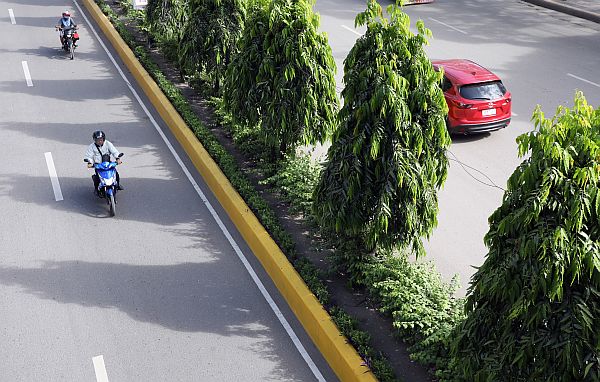
The Cebu City government plans to relocate hundreds of full grown trees as the city’s roads will be widened to prepare for the Bus Rapid Transit (BRT) system. Among the trees to be earthballed would be the Indian trees located on the center island of Osmeña Blvd.
CDN PHOTO/TONEE DESPOJO
BUS RAPID TRANSIT (BRT)
IT is a price of development that Cebu’s private sector understands – full grown trees along roads will have to be removed to widen the city’s streets to give way for buses.
But the groups are banking on the city’s assurance that the trees, numbering 2,166, will be earthballed or transplanted somewhere else and not cut.
The Cebu Bus Rapid Transit (BRT) project is a World Bank (WB)-funded P10.6-billion urban passenger transport system that will replace heavy-polluting public utility jeeps with buses to improve the city’s transport system, decongest roads, improve the level of service, safety and environmental efficiency, according to a WB abstract on the project.
“The effort to save all the trees from being cut is a commendable act by our duty-bearers. This serves as a huge step towards a livable city that will benefit all Cebuanos,” Liza Osorio, co-founder of the Philippine Earth Justice Center (PEJC), told Cebu Daily News.
Osorio was referring to Cebu City environmental consultant, Nida Cabrera’s pronouncements that the trees which are along sidewalks and center islands of the BRT corridor from Barangay Bulacao in the south district to Barangay Talamban in the north, will be relocated and not cut.
Cabrera said that only around 30 trees will be “harvested” or cut down since they are too big and difficult to transfer.
The Movement for a Livable Cebu (MLC) supports the move in a position paper released by the multi-sectoral group.
“If cutting is the only option, select the trees that are not indigenous to Cebu first and perhaps the rest can be earthballed. MLC has no objection to the complete removal of the center island along Osmeña Boulevard,” the group said.
“The (center) island has no historical value whatsoever, and the Indian Trees are not indigenous to this country,” MLC added.
Based on records from the Cebu City Environment and Natural Resources Office (CCENRO), 486 out of the 2,166 trees affected are Indian trees.
Other species include narra (665), fire trees (471), mahogany (203), and ipil-ipil trees (197).
MLC suggests that the trees should be transferred to areas which are not far from their current location or in parks, roadways and walkways.
Sidewalks of B. Rodriguez St. Gen. Maxilom Ave. were suggested as transfer sites.
“We live in a tropical country, and thus parks and walkways may be designed with green canopies to provide shade for the using public,” said MLC.
The city government also launched an adopt-a-tree program for groups or individuals interested to take care of the trees by sending a letter of intent and site sketch to CCENRO.
CCENRO will then inspect the area to determine if this was a suitable site to replant the trees.
“As for the private sector and civil society, let’s do our part and find ways to help our city. The adopt-a-tree program is certainly a very good place to start. How about it Cebu? Let’s get it done,” MLC lead convenor Marc Canton said in a post on Facebook.
A public hearing at the Rizal Public Library has been set tomorrow as part of requirements for the application of an Environmental Compliance Certificate (ECC) from the Department of Environment and Natural Resources (DENR).
Environmental lawyer and PEJC co-founder Gloria Ramos hopes that experts, especially green urban planners, will join the public hearing in order to share their ideas and proposals.
“Sakit sa dughan (It hurts) that the trees are seen as collateral damage and threats to development. I hope authentic green urban planners are consulted and scientists to speak out as well,” Ramos told CDN.
BRT project implementation unit (PIU) head Rafael Yap said that the first phase of the project will involve the construction of bus stops along Osmeña Blvd. which may start towards the end of the year.